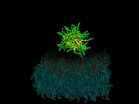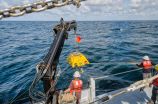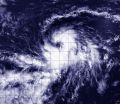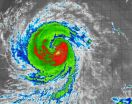(Press-News.org) (SACRAMENTO, Calif.) -- In a discovery that is likely to rewrite immunology text books, researchers at UC Davis have found that early exposure to inflammatory cytokines, such as interleukin 2, can "paralyze" CD4 T cells, immune components that help orchestrate the body's response to pathogens and other invaders.
This mechanism may act as a firewall, shutting down the immune response before it gets out of hand. However, from a clinical standpoint, this discovery could lead to more effective cancer immunotherapies, better drugs for autoimmune conditions and new ways to expedite recovery from sepsis. The research, online July 28, appears in today's print edition of the journal Immunity.
"There's a three-signal process to activate T cells of which each component is essential for proper activation," said first author Gail Sckisel, a post-doctoral fellow. "But no one had really looked at what happens if they are delivered out of sequence. If the third signal - cytokines - is given prematurely, it basically paralyzes CD4 T cells."
To be activated, T cells must first recognize an antigen, receive appropriate costimulatory signals, and then encounter inflammatory cytokines to expand the immune response. Until now, no one realized that sending the third signal early - as is done with some immunotherapies - could actually hamper overall immunity.
"These stimulatory immunotherapies are designed to activate the immune system," said Sckisel, "but considering how T cells respond, that approach could damage a patient's ability to fight off pathogens. While immunotherapies might fight cancer, they may also open the door to opportunistic infections."
This was shown in mice which, after receiving systemic immunotherapy, had trouble mounting a primary T-cell response. The finding was confirmed in samples from patients receiving high-dose interleukin 2 therapy to treat metastatic melanoma.
"We need to be very careful because immunotherapy could be generating both short-term gain and long-term loss," noted lead author William Murphy, professor and acting chair in the UC Davis Department of Dermatology. "The patients who were receiving immunotherapy were totally shut down, which shows how profoundly we were suppressing the immune system."
In addition to illuminating how T cells respond to cancer immunotherapy, the study also provides insights into autoimmune disorders. The researchers believe this CD4 paralysis mechanism could play a role in preventing autoimmunity, a hypothesis they supported by testing immunotherapy in a multiple sclerosis model.
By shutting down CD4 T cells, immune stimulation prevented an autoimmune response. This offers the potential to paralyze the immune system to prevent autoimmunity or modulate it to accept transplanted cells or entire organs.
"Transplant patients go on immunosuppressants for the rest of their lives, but if we could safely induce paralysis just prior to surgery, it's possible that patients could develop tolerance," said Sckisel.
CD4 paralysis may also be co-opted by pathogens, such as HIV, which could use this chronic inflammation response to disable the immune system.
"This really highlights the importance of CD4 T cells," said Murphy. "The fact that they're regulated and suppressed means they are definitely the orchestrators we need to take into account. It also shows how smart HIV is. The virus has been telling us CD4 T cells are critical because that's what it attacks."
The team's next step is to continue this research in older mice. Age can bring a measurable loss in immune function, and inflammation may play a role in that process.
"For elderly people who have flu or pneumonia, their immune systems are activated, but maybe they can't fight anything else," said Murphy. "This could change how we treat people who are very sick. If we can block pathways that suppress the immune response, we may be able to better fight infection."
INFORMATION:
Other authors were: Myriam N. Bouchlaka, Arta M. Monjazeb, Can M. Sungur, Erik Ames, Annie Mirsoian, Abhinav Reddy and Athena Soulika at UC Davis; Marka Crittenden and Brendan D. Curti at Providence Portland Medical Center; Danice E.C. Wilkins and Kory A. Alderson at the University of Nevada, Reno; Warren Alexander at The Walter and Eliza Hall Institute of Medical Research; Bruce R. Blazar at the University of Minnesota Cancer Center; Dan L. Longo at the National Institute on Aging; and Robert H. Wiltrout at the National Cancer Institute.
This study was supported by the NIH grants R01 CA 095572 and R01 CA 072669 and Prometheus Laboratories Inc.
Scientists are planning for a future in which superbugs gain the upper hand against our current arsenal of antibiotics. One emerging class of drug candidates, called AMLPs (antimicrobial lipopeptides), shows promise, and an August 18 study in the Biophysical Journal explains why: they selectively kill bacterial cells, while sparing mammalian host cells, by clumping together into microscopic balls that stick to the bacterial membrane--a complex structure that will be slower to mutate and thus resist drugs.
"The pressing need for novel antibiotics against resistant strains ...
SAN FRANCISCO--Early data coming in from a massive, four-year deployment of seismometers onshore and offshore in the Pacific Northwest are giving scientists a clearer picture of the Cascadia subduction zone, a region with a past and potential future of devastating "megathrust" earthquakes.
The preliminary results from the Cascadia Initiative include a report of previously undetected, small earthquakes offshore, and seismic imaging that reveals new offshore structures at the subduction zone. The reports, published as a focus section in the September-October 2015 issue ...
Research indicates that the use of condoms may cause some men to experience erection difficulties. However, in a study of 479 heterosexual men who used condoms and were 18 to 24 years old, those who reported condom-associated erection problems were also more likely to experience more generalized erection difficulties.
Investigators also found that more than one-third of participants had never been taught how to use a condom correctly. Clinicians should assess whether men using condoms experience condom-associated erection problems and where appropriate, make referrals ...
Liver diseases affect hundreds of millions of people and cause significant illness and death. A new study indicates that liver scarring (or fibrosis), which can ultimately lead to liver failure, is fairly common. It was present in 5.6% of adults in the Rotterdam Study, a population-based study among individuals in a suburb of Rotterdam, the Netherlands, who were ?45 years old. It was especially prevalent in individuals with diabetes or steatosis, the latter of which occurs when fat cells infiltrate the liver.
"In the context of an aging population and an increasing prevalence ...
New research indicates that use of oral contraceptives may provide benefits for women with inflammatory arthritis.
Among 273 women with early inflammatory arthritis, women who had used oral contraceptives in the past and those who were currently using them reported fewer problems related to how well they can function, their mood, and how active their disease is.
The findings are published in Arthritis Care & Research.
INFORMATION: ...
It's known that brain changes are present in drug addicts even when they have been abstinent for a short period of time. Now new research shows that alterations persist in long-term abstinent heroin-depended individuals as well.
Through the use of functional magnetic resonance imaging, investigators analyzed the brains of 30 heroin-addicted individuals after a long period of abstinence (more than 3 years) and compared the results with those of 30 healthy controls.
The team found that in the former heroin users, there was significant dysfunctional activity in the nucleus ...
The fourth tropical depression of the Atlantic Ocean hurricane season formed today, August 18, 2015 as NASA's Terra satellite passed overhead.
On Aug. 18 at 8:45 a.m. EDT the Moderate Resolution Imaging Spectroradiometer or MODIS instrument aboard NASA's Terra satellite captured a visible image of newborn Tropical Depression 4 in the central Atlantic Ocean. The image showed thunderstorms banding around the center of circulation in all quadrants except the northwest.
The National Hurricane Center (NHC) also uses measurements from the Advanced Scatterometer or ASCAT instrument ...
NASA-NOAA's Suomi NPP satellite passed over Typhoon Goni and gathered infrared data that helped identify the strongest part of the storm as the south and eastern quadrants.
The Visible Infrared Imaging Radiometer Suite (VIIRS) instrument aboard NASA-NOAA's Suomi satellite captured an infrared image of Goni on August 18 at 4:18 UTC (12:18 a.m. EDT) that showed the strongest thunderstorms with the coldest cloud top temperatures (near -63F/-53C) were in the eastern and southern quadrants.
The Joint Typhoon Warning Center noted that animated enhanced infrared satellite ...
Irvine, Calif., Aug. 18, 2015 - Researchers from the University of California, Irvine and NASA have uncovered a remarkably strong link between high wildfire risk in the Amazon basin and the devastating hurricanes that ravage North Atlantic shorelines. The climate scientists' findings appear in the journal Geophysical Research Letters near the 10th anniversary of Hurricane Katrina's calamitous August 2005 landfall at New Orleans.
"Hurricane Katrina is indeed part of this story," said James Randerson, Chancellor's Professor of Earth system science at UCI and senior author ...
CHICAGO--From a food science and technology perspective, sugar (sucrose) plays several roles when it comes to the functional properties in food. In the September issue of Comprehensive Reviews in Food Science and Food Safety published by the Institute of Food Technologists (IFT), authors from the University of Minnesota write about the functional properties of sugar and why they are often added to foods.
1. Taste: Sweetness improves the palatability of many foods. Adding sugar to foods with high nutrient quality may increase the chance they are consumed. In addition, ...



